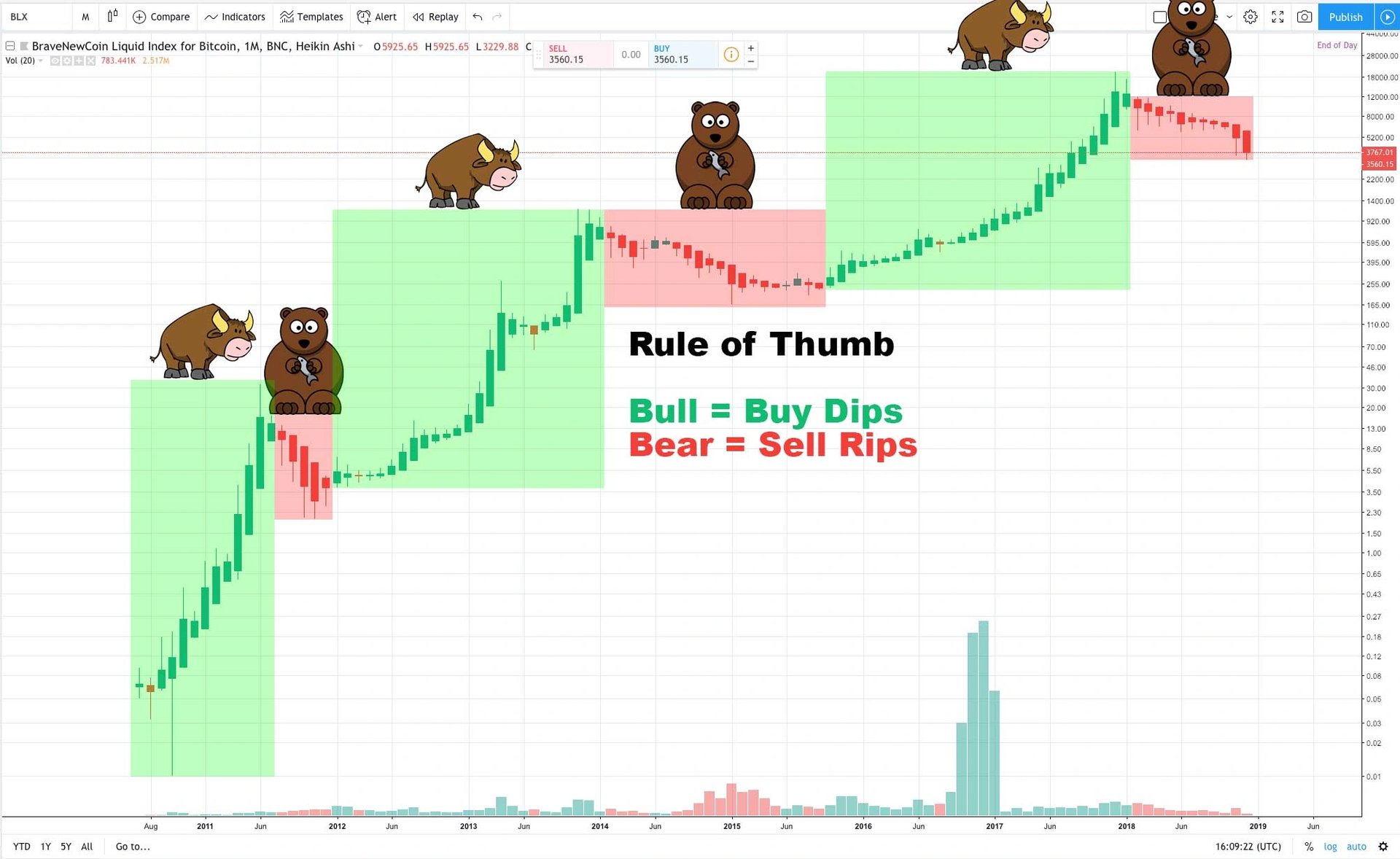위키 구독하기
Share wiki
Bookmark
Bull Market
에이전트 토큰화 플랫폼 (ATP):에이전트 개발 키트(ADK)로 자율 에이전트 구축
Bull Market
**강세장(또는 강세장 랠리)**은 일반적으로 견고한 경제와 고용 증가에 힘입어 자산 가격이 지속적이고 꾸준히 상승하는 것을 말합니다. 강세장 동안에는 긍정적인 경제 여건이 나타나 시장의 상승 추세를 나타내며, 종종 현재 상승 추세에 대한 투자자들의 긍정적인 심리가 수반됩니다.[1][2] 암호화폐 시장에서 강세장은 암호화폐 가격이 상승하거나 상승할 것으로 예상되는 기간입니다. 이는 일반적으로 수요가 공급보다 많고 투자자들이 암호화폐 산업의 미래에 대해 낙관적일 때 발생합니다.[8]
개요
"강세장"이라는 용어는 시장 내 긍정적인 가격 추세를 설명합니다. 이 개념은 전통적인 시장뿐만 아니라 암호화폐 영역에도 널리 적용됩니다. 본질적으로 강세장은 비교적 짧은 기간 동안 상당한 가격 상승을 특징으로 하는 강력한 상승 추세를 나타냅니다.
강세장을 정확히 파악하는 데 사용되는 보편적으로 표준화된 지표는 없습니다. 주식 시장에서 강세장에 대한 가장 널리 받아들여지는 정의는 주가가 최근 저점에서 20% 이상 상승할 때입니다. 이는 가격이 지속적인 기간 동안 20% 이상 하락하는 약세장과 대조적입니다. [1][4]
전통적인 시장과 달리 암호화폐 시장은 상대적으로 규모가 작고 그 결과 변동성이 더 높습니다. 결과적으로 단 1~2일 만에 40% 이상의 급격한 가격 급등이 빈번하게 발생하는 상당하고 지속적인 강세장 랠리를 목격하는 것은 드문 일이 아닙니다.[3][9]

지표
강세장을 식별하는 것은 종종 다양한 암호화폐에서 일관된 상승 추세를 보이는 가격 추세를 관찰하는 것만큼 간단할 수 있습니다. 강세장을 결정하기 위해 더 포괄적인 재무 분석을 위해 다음 요소와 지표가 고려됩니다.
- 가격 상승: 강세장 랠리는 일반적으로 증가된 자신감과 더 큰 수요로 인한 장기적인 가격 상승 단계를 특징으로 합니다. 예를 들어, 2020년과 2021년 강세장 랠리에서 비트코인과 이더리움과 같은 주요 암호화폐는 각각 69,000달러와 4,880달러의 사상 최고치에 도달했습니다. [6]
- 긍정적인 시장 심리: 강세장 동안에는 일반적으로 상승 추세에 대한 낙관론과 자신감을 특징으로 하는 긍정적인 투자 심리가 있습니다. 즉, 투자자들은 암호화폐의 잠재력에 대해 자신감과 열정을 가지고 있으며, 더 많은 위험을 감수하고 더 많은 돈을 투자할 의향이 있습니다. 이러한 심리는 설문 조사, 시장 심리 지표 및 언론 보도를 통해 측정할 수 있습니다.[1][4][5]
- 거래량 증가: 강세장은 일반적으로 거래량 증가를 목격합니다. 즉, 더 많은 사람들이 암호화폐를 사고 팔고 있으며, 이는 더 많은 유동성과 가격 발견을 만듭니다. 이러한 거래량 증가는 투자자의 자신감 증가와 시장에 대한 적극적인 참여를 의미합니다.[2][5]
- 시가총액 증가: 유통 중인 모든 암호화폐의 총 가치가 증가하고 있으며, 이는 암호화폐에 대한 관심과 채택이 증가하고 있음을 반영합니다.[8]
예시
2013년 강세장
비트코인의 가격은 1월 약 13달러에서 12월 1,000달러 이상으로 급등하여 상당한 관심을 끌고 암호화폐 시장의 미래 발전을 위한 기반을 마련했습니다. [5]
2017년 강세장 랠리
암호화폐 시장에서 가장 상징적인 강세장 중 하나는 2017년에 발생했습니다. 이 기간 동안 암호화폐 가격은 전례 없는 급등을 경험했습니다. 비트코인은 2017년 12월 거의 20,000달러의 사상 최고치에 도달했습니다. 이더리움, 리플, 라이트코인과 같은 다른 암호화폐도 상당한 가격 급등을 경험했습니다. 2017년 강세장 랠리는 비트코인 선물 출시, 암호화폐에 대한 주류 인식 및 채택 증가, 암호화폐 시장에서 새로운 프로젝트와 혁신의 등장과 같은 요인에 의해 주도되었습니다.[5]
2019년 강세장
2018년 약세장 이후 암호화폐는 2019년에 회복세를 보였습니다. 연초 약 3,700달러였던 비트코인 가격은 6월 말까지 거의 14,000달러까지 급등했습니다. 이 랠리는 암호화폐 시장에 대한 투자자들의 관심과 낙관론을 되살렸습니다. [5]
2020-2021년 강세장
비트코인의 가격은 2020년 3월 약 4,000달러에서 2021년 4월 64,000달러를 넘는 사상 최고치로 상승했습니다. 이더리움과 다양한 알트코인도 이 기간 동안 상당한 가격 상승을 누렸습니다. 2020-2021년 강세장 랠리는 전통적인 금융에 대한 디지털 및 분산형 대안에 대한 수요 증가를 야기한 COVID-19 팬데믹, 테슬라가 15억 달러 상당의 비트코인을 매입하는 등 암호화폐의 기관 및 기업 채택, 탈중앙화 금융(DeFi) 및 대체불가토큰(NFT)과 같은 암호화폐 산업의 새로운 부문 및 추세의 개발과 성장과 같은 요인에 의해 촉진되었습니다.[5][8]
2021년 알트코인 강세장 랠리
2021년 비트코인의 랠리와 병행하여 수많은 알트코인에 대한 상당한 강세장이 있었습니다. 이더리움, 바이낸스 코인, 카르다노와 같은 암호화폐는 상당한 가격 상승을 경험했습니다. 탈중앙화 금융(DeFi) 및 대체불가토큰(NFT)과 같은 요인이 이러한 급증을 주도하는 데 역할을 했습니다. [5]
이러한 다양한 강세장은 암호화폐 시장의 역동적이고 진화하는 본질을 보여주며, 상당한 가격 상승 기간을 보여주고 투자자와 열렬한 팬들의 관심을 사로잡았습니다.[5]
잘못된 내용이 있나요?
